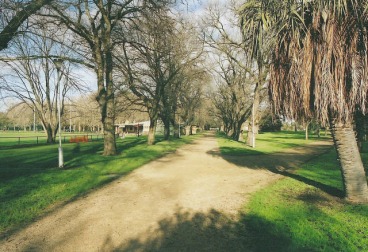Maintenance of the Elm Avenue in Caulfield Park
We, the Friends of Caulfield Park, are concerned at the long years of neglect of the Heritage Area of Caulfield Park and its adverse effect on the trees therein.
We believe that an audit of the trees should be made with a view to managing their replacement over a period of decades such that those that are reaching a point where they are no longer sustainable can be replaced by mature specimens that have been growing off-site in preparation for this event.
The advantage of this policy is that there is no discontinuity in the visual amenity enjoyed by park users.
Of particular concern is the Elm Avenue, the most important remaining stand of Elms in Melbourne.
We list below the steps that should be undertaken in regard to this audit, particularly in regard to the elms.
What an arborist should be looking for in the Elm Avenue
Identification.
We believe that an audit of the trees should be made with a view to managing their replacement over a period of decades such that those that are reaching a point where they are no longer sustainable can be replaced by mature specimens that have been growing off-site in preparation for this event.
The advantage of this policy is that there is no discontinuity in the visual amenity enjoyed by park users.
Of particular concern is the Elm Avenue, the most important remaining stand of Elms in Melbourne.
We list below the steps that should be undertaken in regard to this audit, particularly in regard to the elms.
What an arborist should be looking for in the Elm Avenue
Identification.
- First, each tree should be identified.
- Are they all of the same elm species, or have later replacements been of different varieties?
- What is their spacing – are there gaps where trees need to be inserted?
- Provide an estimate of their individual ages; some were replanted in the 70s.
- What are their physical characteristics?
- What is their circumference a meter above the ground?
- Large trees may develop fork weaknesses. Where the trunks have no weakness, it is desirable to use bolts or cables to provide support for these trees. This is a medium term solution and specific replacement trees should be grown in preparation for the time when they need replacement.
- Limb shed does not appear to be a major problem with the elms. However, where this has not been attended to, decay, or even termites, may attack and weaken the tree. Where such wounds are discernible, they should be treated insofar as this is possible.
- A further approach is to undertake end weight reduction. This enables the branches to be retained and reduces the risk of further damage due to breakage or tearing. This will enhance the appearance of the tree as well as increasing safety.
- Dead wood should be removed and action taken to prevent risk of ensuing decay.
- Where trees intersect, care should be taken to ensure that they do not weaken each other by adverse contact.
- The present extended dry period, ascribed to climate change, means that the root system is struggling to find adequate moisture, especially during the heat of summer.
- A program of mulching of individual trees to the drip line should be embarked on. This will improve the soil and to ensure the trees receive adequate moisture and food, thus improving the safe, useful life expectancies of the trees.
- Drip irrigation will be the most suitable means of watering the elms once they have been mulched. Providing that a reasonable thickness of mulch is used and maintained (say 80 mm). Then there will be no need to disturb the root network.
- Most trees experience, and can tolerate, a certain amount of decay or hollowing without being rendered structurally unsound. It is generally felt that over a third of the trunk diameter needs to be decayed or hollow before there is a significant decrease in trunk strength.
- The status of trunk decay (if any) of each tree should be assessed. The present policy of leaving the trees to rot out where branches were cut off or broken is inadequate and suitable measures to remedy any decay should be recommended.


